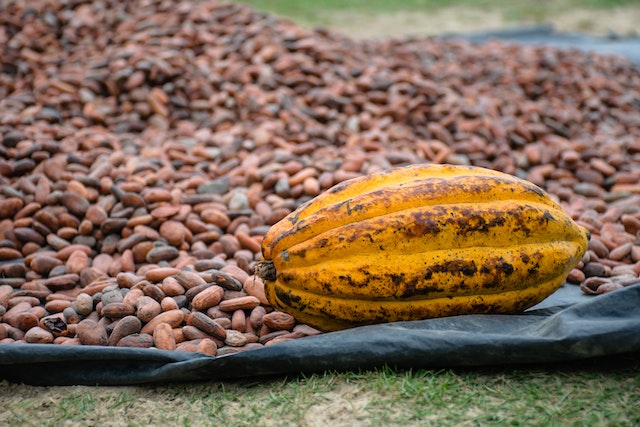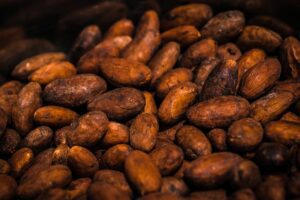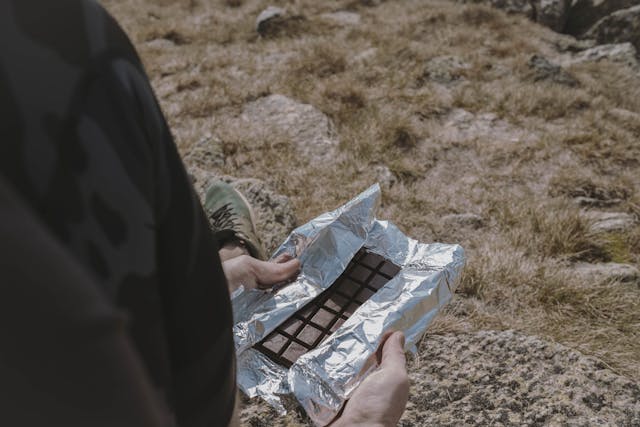
Brewed Cacao vs. Coffee: 8 Reasons to Drink Cacao Instead of Coffee
February 15, 2023
Major Effects of the Bantu Peoples Migration
April 2, 2023Sustainable Cocoa:
Why Lab-Grown Chocolate Is Not the Solution
At the root of the challenges to sustainable cocoa is farmer and farm worker poverty. Child labour, forced labour, and risks to the planet through deforestation and forest degradation are only secondary challenges caused by farmers’ desperate attempts to allay the economic effects of the chronically low incomes from their crops.
In this article, we look at what is sustainable cocoa, the challenges facing cocoa sustainability, what is being done holistically to tackle these challenges, and why we do not believe that lab-grown chocolate is the best way to go in making chocolate slave-free or eco-friendly.
What is Sustainable Cocoa?
Actors in cocoa action plans all agree on one thing: sustainable cocoa has three levels of responsibility: social, economic, and environmental.
Therefore, sustainable cocoa is cocoa farmed and marketed in a way that is profitable to the farmer, friendly to the environment, and respects human rights. Sustainable cocoa practices target the primary challenge of the supply chain from the roots, collaborating with farmers to prevent secondary hazards.
For a better understanding of the multi-level aspects of making cocoa sustainable, a deeper understanding of the challenges to sustainability is important.
Challenges Facing Cocoa Sustainability
1. Low Commodity Prices
This is at the root of challenges to cocoa sustainability. Over 70% of the world’s cocoa is produced by over 2 million farmers in West Africa. Other cocoa-growing regions of South America and Indonesia make up the remaining percentage.
Although these farmers and farm communities bear the brunt of the challenges in the supply chain, they earn between 3-6 pence of the price for an average bar of chocolate in a supermarket.
Low incomes significantly drive producers to seek to make ends meet in ways that violate human rights and encroach on protected ecosystems. This leads to a vicious cycle. Tackling this root problem alongside raising awareness and providing training motivate farmers to adopt good agricultural practices.
2. Child Labour
Having children help out on the farms doing age-appropriate tasks is not child labour. Child labour on cocoa farms includes children staying out of school to work on farms and using hazardous tools. This child labour results from farmer poverty in two ways: parents’ inability to send children to school and parents using children on farms in place of hired labour to cut down on cost of production.
3. Forest Degradation & Deforestation
Monoculture farming, coupled with crushing poverty, pushes farmers to either rely heavily on agrochemicals or encroach on forests for fertile land to increase yields. This leads to deforestation and forest degradation with their attendant consequences on biodiversity loss and greenhouse gas emissions.
4. Poor yields from pests and unfavourable climate conditions
Disease, droughts, monoculture, and wildfires are among the significant threats to good yields.
Sustainable Cocoa Solutions Employed by Various Initiatives
Over the years, great progress has been achieved by various initiatives to tackle the challenges to sustainable cocoa farming. Being a collective effort, sustainability has been a journey of research, gains, lessons, and innovative technology geared towards smoother processes and higher gains.
Partners in this sustainable cocoa farming include farmers and farm community groups, the international community, national governments, small and major chocolate companies, and international and local civil society organisations.
Notable among these organisations are the Rainforest Alliance that merged with UTZ certification in 2018, the World Cocoa Foundation, Cocoa Life, Mighty Earth, Global Forest Watch, and IMAGE tool.
Individually and collectively, these initiatives proffer sustainable cocoa solutions that seek to improve farmers’ livelihoods, eradicate child labour, battle and reverse deforestation, supply drought-resistant plants, and create technology that identifies and monitors deforestation hotspots.
The end goal is more cocoa on less land in an equitable sector that benefits all participants in the supply chain.
1. Rewarding climate-conscious farmers with premium prices
Also known as Fair Trade, certification programs discourage deforestation by incentivising farmers who adopt sustainable cocoa farming techniques. These incentives include minimum and premium prices that act as buffers against commodity price drops.
The Rainforest Alliance, for example, works with other signatory partners, not just to pay premium prices for FairTrade certified cocoa, but also train farmers and farmer groups on sustainable practices like regenerative and smart agriculture, and savings schemes. Farmers in this scheme have their farms GPS-mapped and farm-forests boundaries are monitored with satellite imagery.
These farmer-centric approaches promote farmer livelihoods, protect human rights, and conserve forests and biodiversity, thereby helping humanity thrive alongside the Earth.
2. Pest and drought-resistant cacao hybrids
International organisations and national governments working through cooperatives distribute pest and drought-resistant varieties of cacao to smallholder farmers.
3. Agroforestry and regenerative agriculture
Agroforestry is the mixed cultivation of crops alongside other trees and shrubs for environmental and economic benefits. For cocoa farming, these other trees act as shades over the cacao tree, increasing yields and mitigating the negative impact of fluctuating climatic conditions. Together with shrubs, these trees trap carbon, preserve biodiversity, and help keep the soil healthy.
Regenerative agriculture is a sustainable farming approach that applies agroforestry on all fronts—shade trees to protect the crops and soils such that the need for pesticides is cut off. The ultimate goal is sustainable practices that add to nature’s richness.
International organisations through government and local community participation are seeing laudable progress in agroforestry implementation on cocoa farms as well as general landscape management towards restoring forests and helping rivers flow all year round.
4. Diversification of crops and incomes
As a consequence of agroforestry, this scheme offers farmers extra sources of income. Fruit-bearing shade trees augment farmers’ income while the encouragement of animal husbandry along cacao farming act as a buffer to poor yields from unexpected negative climate impact.
5. GPS mapping of farms and satellite monitoring of farm-forest borders
To ensure cocoa is deforestation-free, these technology-driven solutions, employed by many industry key players, identify deforestation hotspots and also provide a wealth of information about farming methods on mapped cocoa farms. The goal is to source 100% sustainable cocoa.
The Role of Direct Trade Chocolate Makers in Promoting Cocoa Sustainability
So far, we’ve talked about sustainability efforts from global giants that help buyers source FairTrade certified cocoa. That’s besides the unseen, underappreciated work of bean-to-bar chocolate makers who don’t get their cocoa from the commodity or Fair Trade markets.
These chocolate makers are either direct trade buyers who pay above FairTrade minimum and premium, or cacao farmers who control their supply chain from the farm to the shelf, ensuring that the people along the supply chain are adequately compensated for their value.
Unlike Fair Trade, direct trade is not a certification, but a trade relationship, which most times entails buyers developing a close relationship with the farmers, farm practices, and farming communities. Done in good faith, direct trade is hugely superior to Fair Trade. Without the downsides to certification (which might be blind in some instances), direct trade guarantees bean quality for the buyer, and without a middleman, direct trade ensures adequate compensation for the producer. This relationship also preserves the purity of single-origin chocolates.
At Bantu Chocolate, for example, we’re farmers and single-origin chocolate makers. Our farm in Cameroon is a full-fledged agroforestry, regenerative farm powered by solar energy. We pay a living wage to our farm workers that is 6 times higher than the commodity price and 3 times higher than the Fair Trade minimum.
Like us, there are many direct trade bean-to-bar or tree-to-bar chocolate makers that hold true sustainability at the core of what they do.
READ: UK Artisan Chocolate Brands Worth Your Taste Buds
Lab-Grown Chocolate is Not the Solution to Sustainable Cocoa
While other initiatives are driven by social, economic, and environmental motives to make cocoa sustainable, lab-growers sidestep this multi-level aspect to cut off land-farmed cocoa producers all together. This elevates the goal of slave-free, eco-friendly chocolate over the social and economic responsibility of ensuring that smallholder farmers, who supply most of the world’s cocoa, earn a living wage from their labour.
It is not eco-friendly if it is only eco-friendly. That is, the drive to protect the planet should not be at the expense of depriving inhabitants of the planet of their livelihood, no matter how little, when there have been strides of getting the planet and its inhabitants to thrive in harmony without one sacrificing the other.
The claim of lab-growers that only a smaller fraction of the cacao fruit is used is borne out of ignorance of the by-products of cocoa production. While it is true that only the seed of cacao is used to make chocolate, chocolate is not the only end-product of the cacao tree. Below are a few uses of other parts of the cacao fruit, which serve as extra income for farmers.
Cacao Pulp: The white pulp that surrounds the raw cacao bean is a source of nutritious cacao pulp juice. The same pulp when sweated out during bean fermentation can be used to make alcoholic drinks like gin and brandy.
The Cocoa Pod Husks: Cacao pod husk is rich in protein, fibres, potassium, and other minerals which can be formulated into animal feed, dietary fibre, soap, organic agrochemicals, and catalysts for biofuel production.
Cocoa Shell: Just like the pod husks, this fibrous coat removed from the bean before or after roasting is an ingredient for animal feed, being rich in protein, fibre, and antioxidants. It can also be used for baking and confections, and in biofuel production.
More Thoughts About Sustainable Cocoa Without the Cocoa Farmer
1. Rising Cocoa Supply
Although only a few countries account for most of the world’s cocoa, other growing areas are gaining traction and aid to boost production, according to this 2022 expert market research report. The same report highlights the increasing demand for organic and sustainable variants of cocoa, a trend that’s expected to only grow, with the demand for derivative products like non-for-chocolate-making cocoa butter expected to rise.
More may still need to be done to completely eradicate deforestation and child labour from cocoa farming, but we can applaud what has been done so far to ensure consumers continue to get their favourite treat and derivative products from shops and supermarket shelves with the supply chain intact.
2. Consumer Demands
Current trends have created passionate consumers who want to know where their food comes from and how it is farmed. These consumers want to buy and eat responsibly, knowing that their wallet is making the difference in the industry. This means sustainability issues are at the forefront of their attitude towards what they eat.
Fair Trade certification and direct trade labour to satisfy that demand without sacrificing the farmer and farm worker incomes. These sustainability efforts also mean a lot to the farmer who not only farms for a living but also for the passion of driving positive social change through their trade.
Lab-grown chocolate cuts off these social and economic benefits at the communal farming level.
3. The Complexity of Chocolate Flavours
Any connoisseur will tell you that there’s no particular chocolate flavour. This is because various factors influence the final product tastes, giving rise to a diversity in chocolate flavour. Bean origin (soil and farming techniques), fermentation and drying, and factory processes all contribute to giving that bar on your taste buds its unique taste.
That complexity contributes to the ‘specialness’ of the world’s favourite treat, giving consumers’ palate an array of different flavours. Are we going to cut this off by formulating everything in a test tube?
This Multi-billion Dollar Industry Can Be Sustainable
Sustainable without cutting off the farmer at the start of the supply chain. Great strides have been attained over the years, and much remains to be done, but a responsible solution to issues around sustainable cocoa can never be to deprive the farmer of his livelihood just to make chocolate eco-friendly.
Eco-friendly is not truly eco-friendly if it strips the producer of his means of living where they are viable alternatives to enable a better future for both producer and the environment. True sustainability should be both eco-friendly and farmer-friendly.
As environmentally friendly farmers and conscious consumers, we believe that sustainable cocoa that is focused on the primary challenge of farmer poverty tackles secondary challenges like deforestation and child labour, resulting in products that make a better difference to consumers who care about food provenance and food processing.
References
https://www.worldcocoafoundation.org/blog/a-just-transition-for-cocoa-farmers/
https://www.worldcocoafoundation.org/initiative/cocoa-forests-initiative/
https://www.cargill.com/sustainability/cocoa/protect-our-planet
https://www.sciencedaily.com/releases/2015/09/150910110832.htm
https://www.sciencedirect.com/topics/biochemistry-genetics-and-molecular-biology/theobromine
https://www.webmd.com/diet/health-benefits-cacao-nibs
https://www.hopkinsmedicine.org/Press_releases/2004/09_29_04.html
https://goodking.co/pages/cacao-vs-coffee
https://www.healthline.com/health/food-nutrition/quitting-caffeine-benefits
.
Chocolate Extinction: Fact vs. Fiction + What Chocolate Lovers Can Do
Chocolate ExtinctionFact vs. Fiction, What Consumers Can Do Share On Facebook Twitter Email Is the world really running out of chocolate? Not really. Currently the global […]
Corporate Chocolate Gifting Ideas to Appreciate Employees and Delight Clients
Corporate Chocolate GiftingHow to Appreciate Employees & Delight Clients Share On Facebook Twitter Email When it comes to corporate gifting, a one-gift-fits-all approach just doesn't cut […]
Cacao Supper Club at Home: Guide to Tasting Chocolate, Cacao Tea, and Pulp Juice
Cacao Supper Club at HomeGuide to Tasting Chocolate, Cacao Tea, and Pulp Juice Share On Facebook Twitter Email Imagine gathering around the table with a few […]






